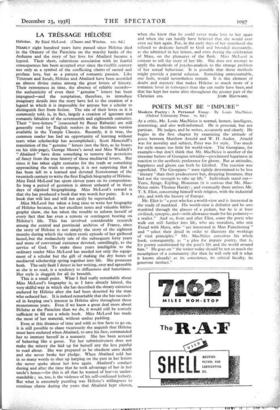LA TRES-SAGE HELOTSE
Haase. By Enid McLeod. (Chatto and Windus. I2S. 6d.) NEARLY eight hundred years have passed since Heloise died in the Oratory of the Paraclete on the marshy banks of the Arduzon and the story of her love for Abailard became a legend. Their short, calamitous association with its fearful consequences has been accepted ever since the twelfth century not only as a symbol of the conflicting claims of sacred and profane love, but as a pattern of romantic passion. Like Tristram and Iseult, HeloIse and Abailard have been accorded an almost divine status among the great lovers of history. Their remoteness in time, the absence of reliable records— the authenticity of even their " genuine " letters has been impugned—and the temptation, therefore, to introduce imaginary details into the story have led to the creation of a legend in which it is impossible for anyone but a scholar to distinguish fact from fiction. The tale of their loves as it is commonly told, is, in fact, largely a creation of ignorant and romantic fabulists of the seventeenth and eighteenth centuries. Their " love-letters " (concocted by Bussy Rabutin) are still generally read by English readers in the factitious version available in the Temple Classics. Recently, it is true, the common reader has had an opportunity of learning without tears what scholarship has accomplished ; Scott Moncrieff's translation of the " genuine " letters (not the first, as he boasts on his title-page), George Moore's novel and Miss Waddell's " Abailard " have done something to remove the accretions of fancy from the true history of these mediaeval lovers. But since •it has taken eight centuries for the truth or something approaching the truth to emerge, it is not surprising that it has been left to a learned and devoted Scotswoman of the twentieth century to write the first English biography of Heloise. Miss Enid McLeod has spent eleven years on its composition. So long a period of gestation is almost unheard of in these days of slipshod biographising. Miss McLeod's reward is that she has produced a book that was worth her pains. It is a book that will last and will not easily be superseded.
Miss McLeod has taken a long time to write her biography of Heloise because, as her excellent notes and valuable biblio- graphy show, she has taken the trouble to inform herself of every fact that has even a remote or contingent bearing on Heloise's life. This has involved considerable research among the central and provincial archives of France, since the story of Heloise is not simply the story of the eighteen months during which the violent erotic episode of her girlhood lasted, but the melancholy tale of the subsequent forty years and more of conventual existence devoted, unwillingly, to the service of God. To make these years intelligible to the ordinary reader Miss McLeod has needed not only the equip- ment of a scholar but the gift of making the dry bones of mediaeval scholarship spring together into life. She possesses both. The only fault I detect in her writing, easy and agreeable as she is to read, is a tendency to diffuseness and luxuriance. Her style is sluggish for all its breadth.
This is a small point. What I find really remarkable about Miss McLeod's biography is, as I have already hinted, the very skilful way in which she has described the dreary existence endured by Heloise after she had been deserted by the man who seduced her. It is indeed remarkable that she has succeed- ed in keeping one's interest in Heloise alive throughout those monotonous years. Even if we knew a great deal more about Heloise at the Paraclete than we do, it would still be scarcely sufficient to fill out a whole book. Miss McLeod has made the most of her material, without undue padding.
Even at this distance of time and with so few facts to go on, it is still possible to share vicariously the anguish that Heloise must have endured when Abailard, to save his face, commanded her to immure herself in a nunnery. She has been accused of behaving like a goose. Yet her submissiveness does not make the misery she laid up for herself any the less painful to read about. She was prepared to be obedient unto death and she never broke her pledge. When Abailard told her in so many words to shut up harping on the past in her letters she never spoke about her love again. Abailard's conduct during and after the time that he took advantage of her in her uncle's house—for this is all that he wanted of her—is under- standable ; so, too, is the violence of his self-confessed lechery. But what is extremely puzzling was Heloise's willingness to continue chaste during the years that Abailard kept silence, when she knew that he could never make love to her again and when she can hardly have believed that she would ever even see him again. For, in the early days of her sisterhood she refused to dedicate herself to God and brooded incessantly, as she admitted in her letters, and even during the celebration of Mass, on the pleasures of the flesh. Miss McLeod is content to tell the story of her life. She does not attempt to apply the methods of psycho-analysis to the strange problem of her sexual behaviour. It is possible that those methods might provide a partial solution. Something unaccountable, one feels, would nevertheless remain. It is this element of doubt and mystery that makes Heloise so much more of a romantic lover in retrospect than she can really have been, and that has kept her name alive throughout the greater part of the


































 Previous page
Previous page